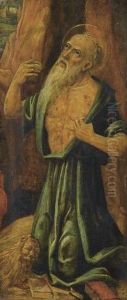Vincezo De Foppa Paintings
Vincenzo Foppa was an Italian painter who was a leading figure in the development of Northern Italian painting during the Renaissance. Born around 1427-1430 in Bagnolo Mella, a small town in the province of Brescia, Lombardy, Foppa was one of the most prominent and influential artists of his time in the region.
Foppa's early life and training are not well-documented, but it is believed that he might have been a pupil of the painter Zanetto Bugatto, who was a court painter for the Duke of Milan. Foppa's work was greatly influenced by the naturalism and the use of perspective that was being developed in Florence and other Tuscan cities during the 15th century. However, he adapted these techniques to his own distinctive style that combined a rigorous attention to detail with rich colors and a certain expressive intensity.
By the 1460s, Foppa had established himself in Milan, which was under the rule of the Sforza family. He received numerous commissions from the Sforza court as well as from ecclesiastical patrons. Among his major works from this period is the fresco cycle for the Portinari Chapel in the Basilica of Sant'Eustorgio, which includes a famous 'Adoration of the Kings'. He also painted a number of significant altarpieces and frescoes in Pavia and its surrounding areas.
In the 1480s, Foppa's style became more reflective of the High Renaissance ideals, and his later works exhibit a greater sense of harmony and balance. Despite his success, little is known about his workshop or potential pupils who might have continued his artistic legacy. Foppa's exact date of death is uncertain, but it is believed that he died around 1515-1516.
Throughout his career, Vincenzo Foppa successfully combined elements of the Early Renaissance style, such as the use of perspective and a focus on naturalism, with a distinctly Lombard character. His work had a lasting impact on the development of Renaissance art in Northern Italy, influencing later painters such as Bramantino and Bernardino Luini. Today, Foppa's paintings can be found in various museums and collections, testament to his enduring legacy as an artist of the Italian Renaissance.
